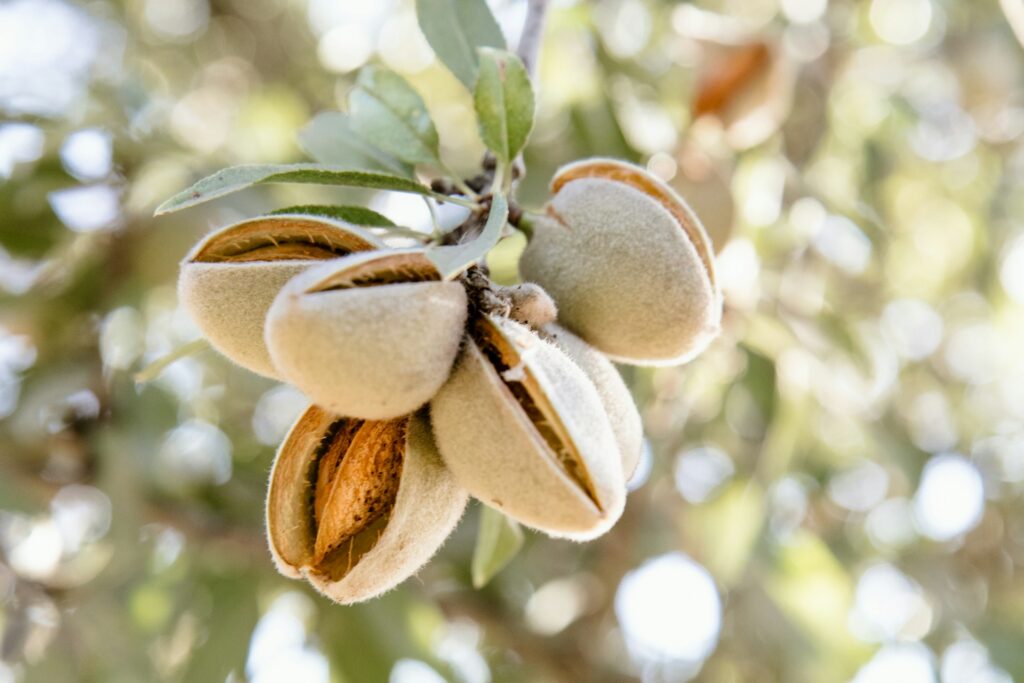Almonds are not only a delicious and nutritious snack but also a versatile ingredient in various culinary dishes.
Growing almonds can be a rewarding experience, whether for personal consumption or commercial production. Here’s a comprehensive guide to help you get started.
Understanding Almond Trees
Almond trees (Prunus dulcis) are native to the Middle East and South Asia. They thrive in Mediterranean climates with warm, dry summers and mild, wet winters. Almond trees are deciduous, shedding their leaves in the fall, and typically grow to a height of 10-15 feet.
Choosing the Right Variety
There are several almond varieties, each with specific characteristics. Some popular varieties include:
Nonpareil: Known for its thin shell and high-quality kernels.
Carmel: A versatile variety with good pollination compatibility.
Mission: Recognized for its hard shell and robust flavor.
Selecting the right variety depends on your climate, soil type, and intended use.
Ideal Growing Conditions
To successfully grow almonds, consider the following conditions:
Climate: Almonds require a warm climate with temperatures between 59-86°F (15-30°C) during the growing season. They also need a chilling period of 200-400 hours below 45°F (7°C) in winter.
Soil: Well-drained, sandy loam soils with a pH between 6.0 and 7.5 are ideal. Avoid heavy clay soils that retain too much moisture.
Sunlight: Almond trees need full sun, at least 6-8 hours of direct sunlight daily.
Planting Almond Trees
Here’s a step-by-step guide to planting almond trees:
Site Selection: Choose a site with good air circulation and full sun exposure.
Soil Preparation: Test the soil pH and adjust if necessary. Amend the soil with organic matter to improve drainage and fertility.
Planting: Plant almond trees in the fall or early spring. Dig a hole twice the width of the root ball and deep enough to cover the roots. Space trees 15-20 feet apart to allow for proper growth.
Watering: Water the trees thoroughly after planting and maintain consistent moisture, especially during the first year.
Care and Maintenance
Proper care ensures healthy growth and a good yield:
Watering: Almond trees require regular watering, particularly during dry periods. Aim to keep the soil consistently moist but not waterlogged.
Fertilization: Apply a balanced fertilizer in early spring and mid-summer. Follow soil test recommendations for specific nutrient needs.
Pruning: Prune almond trees in late winter to early spring to remove dead or diseased branches and shape the tree. Proper pruning improves air circulation and sunlight penetration.
Pest and Disease Control: Monitor for common pests like aphids, spider mites, and navel orangeworms. Use appropriate organic or chemical controls as needed. Watch for diseases like brown rot and bacterial spot, and take preventive measures.
Pollination
Almond trees are not self-pollinating and require cross-pollination from another almond variety. Planting at least two compatible varieties close to each other or introducing honeybee hives can enhance pollination and fruit set.
Harvesting Almonds
Almonds typically mature in late summer to early fall. The hulls split open when the nuts are ready for harvest. To harvest:
Shake the Tree: Gently shake the branches to dislodge the nuts.
Collect and Dry: Gather the fallen nuts and spread them in a single layer to dry in a warm, dry place for 1-2 weeks.
Remove Hulls and Shells: Once dried, remove the hulls and shells to reveal the almond kernels.
Storing Almonds
Store shelled almonds in an airtight container in a cool, dark place. Properly stored almonds can last up to a year. Refrigeration or freezing extends their shelf life.
Growing almonds can be a fulfilling endeavor, providing a bountiful harvest of nutritious nuts. By selecting the right variety, ensuring ideal growing conditions, and providing proper care, you can enjoy the benefits of homegrown almonds. Whether you’re a hobby gardener or aspiring commercial grower, this guide will help you embark on your almond-growing journey.
Common Challenges and Solutions
Growing almonds, like any agricultural endeavor, comes with its challenges. Here are some common issues and how to address them:
Frost Damage: Late spring frosts can damage blossoms and reduce yields. Planting on higher ground, where frost is less likely to settle, and using frost blankets can help protect the trees.
Water Management: Both overwatering and underwatering can harm almond trees. Installing a drip irrigation system can provide consistent moisture while preventing waterlogging.
Nutrient Deficiencies: Yellowing leaves or poor growth may indicate nutrient deficiencies. Conduct regular soil tests and apply the appropriate fertilizers to address any imbalances.
Weed Control: Weeds compete with almond trees for nutrients and water. Mulching around the base of the trees and using organic or chemical weed control methods can help manage weed growth.
Pests: Common pests include aphids, spider mites, and navel orangeworms. Introducing beneficial insects, such as ladybugs, can help control aphid populations. Regular monitoring and the use of organic pesticides can manage other pests.
Diseases: Almond trees can be susceptible to diseases such as brown rot and bacterial spot. Implementing good sanitation practices, such as cleaning up fallen leaves and fruit, and applying fungicides can help prevent disease spread.
Organic Almond Farming
For those interested in organic farming, growing almonds organically involves avoiding synthetic pesticides and fertilizers. Here are some tips:
Soil Health: Use compost and organic matter to improve soil fertility and structure.
Pest Control: Employ biological controls, such as beneficial insects, and use organic-approved pesticides.
Disease Management: Practice crop rotation, proper spacing, and sanitation to minimize disease risks.
Organic farming requires certification, so ensure compliance with local organic farming regulations.
Almond Tree Longevity and Productivity
Almond trees can be productive for 25 years or more with proper care. Here’s how to maximize their longevity and productivity:
Regular Maintenance: Consistent watering, fertilization, and pruning are essential.
Soil Management: Maintain soil health through regular testing and amendments.
Tree Replacement: Plan for gradual tree replacement to ensure continuous production.
Commercial Almond Production
For those considering commercial almond production, here are additional factors to consider:
Market Research: Understand the demand for almonds in your region and identify potential buyers.
Scale: Determine the scale of your operation based on available land and resources.
Infrastructure: Invest in necessary infrastructure, such as irrigation systems, processing equipment, and storage facilities.
Certification and Compliance: Ensure compliance with agricultural regulations and consider obtaining certifications, such as organic or fair trade, to enhance marketability.
Growing almonds can be a rewarding venture, offering both personal satisfaction and potential economic benefits. Whether you are cultivating a few trees in your backyard or planning a large-scale commercial orchard, following the guidelines in this comprehensive guide will help you achieve success. With proper planning, care, and dedication, you can enjoy the delicious and nutritious bounty of homegrown almonds for years to come.






